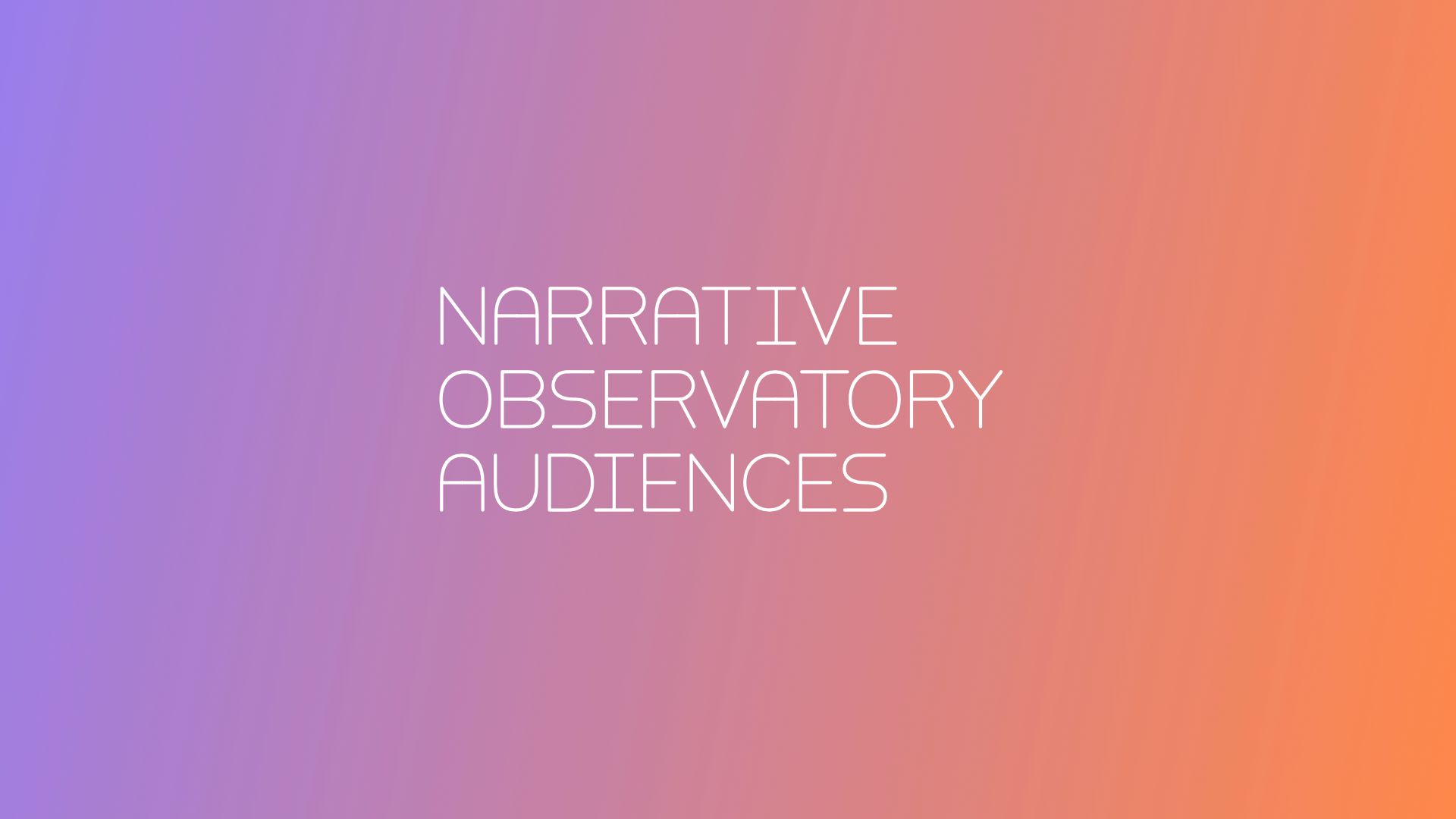Four Principles For Building Power in Media


2025-05-06
At Harmony Labs, the foundation of our work is understanding people and the stories they consume, create, and share to make sense of themselves, their communities, and the world. In our research we utilize a core audience framework, and given how central it is to everything we do, we often get questions about how it works, what it can do to facilitate effective narrative research and strategy, and, critically, how our audiences relate to the other strategic tools people use for thinking about and organizing audiences. Here, we intend to describe the purpose of audience segmentation more generally, and the origins and utility of our specific approach.
The best audience segmentation approaches serve as practical organizing tools, not because they represent scientific truths, but because they provide a common connection across many different people using them—people like storytellers, strategists, advocates, and more. They don’t aim for the kind of precision that any single psychological construct might provide, instead their purpose is to serve as a framework for thinking about how many different constructs interact with humans, describing discrete groups of people with patterns of characteristics.
Generally a segmentation might be considered “good” if it is:
In addition to the above, “great” audience segmentation also generally provides:
It’s also worth noting the purpose of an audience segmentation is not to prioritize strategic targets. A great audience segmentation describes what the audience values and who they are, not what value they bring to any given organization. To be successful, practitioners need both an audience segmentation and a strategic approach to engaging these audiences. Example: the anti-smoking “Truth” campaign—one of the most successful narrative change campaigns in history—set young people as strategic targets but crafted their messages to appeal not to the audience’s age but to their core value of self-determination and their unwillingness to be manipulated.
Since audience segments are distinct from individual psychological constructs and strategic targets, it’s useful to define those first to understand the gap that segmentation can fill.
Psychological constructs are used by psychologists to explain human behaviors. They can be mutable states or relatively immutable traits. For example, Dweck’s growth mindset is part of what drives achievement and learning, and measuring and affecting this construct can explain and modify those specific outcomes.
The 21st century has been something of a golden era of behavioral research and there are all kinds of these psychographics available to explain specific behavior patterns. Some of the most frequently used are racial identity centrality, hostile and benevolent sexism, authoritarianism, social dominance orientation, the Big 5 and various competing models of personality, Moral Foundations Theory, system justification, and social trust among many others. Psychographic constructs like these are typically measured using individual dimensions and the relationships between them are sometimes noted but seldom elaborated upon. When correlations are made they mostly are used to show how a new construct is different from but related to others, and to debate their relative superiority as explanations of specific behaviors.
One notable example of a system of psychological constructs with known relations to each other is Shalom Schwartz’s universal human values which we cover in depth in the next section.
As a result of research on these kinds of psychological constructs, our work incorporates many of these ideas about the psychological processes which drive (distally and proximally) specific behavioral outcomes.
Strategic targets are groups of people defined by their relationship to an organization’s goals that the organization uses to prioritize a variety of engagement and advocacy activities. For example, a democracy advocate might create target groups like “people who don’t know the definition of democracy,” “people who support democracy but have low vote propensity,” or “people who can impact judicial appointments.” These groups are important, and they are a critical part of a strategy, but they’re not useful segments to describe audiences because they only tell us what our organization wants, not who the audience is, what they value, and how they see the world.
Segmentation, then, becomes a means of reducing the complexity that exists in connecting psychological constructs, strategic targets, and the engagement and strategic advocacy activities they are meant to inform. Practically speaking, segments are groups, not dimensions. They can inform which psychological constructs go together naturally within audiences instead of considering thousands of possible combinations individually, and they are rooted in what audiences want and how they think.

The purpose of audience segments is to make it easy to understand all kinds of people, enable effective decision making about how to engage them, and to measure success.
Through the Narrative Observatory @Harmony Labs we have been developing our approach to audience segmentation over the last several years. These segments are based on Shalom Schwartz's universal human values. Values are psychological constructs, and the universal human values are a small group of values which exist in every culture and which have a precisely known set of relations to each other.

Schwartz began his research on values in the 1980s, building on earlier work by social psychologists like Milton Rokeach, with a goal of identifying a comprehensive set of basic values that exist across all societies. Schwartz conducted surveys in dozens of countries, measuring many values in different ways, and then reduced them using a dimensionality technique called Multidimensional Scaling (MDS). The idea behind MDS, factor analysis, and other similar techniques is that you can have many questions which are all intercorrelated in ways that reflect just a few “latent” dimensions that drive responses.
In Schwartz’s original summary of his work he identifies 10 values and, importantly, asserts that those values inscribe a “circumplex,” or a 2 dimensional map defined by inherent tensions between values. For example, values like helping others and achieving individual goals.

The map itself has just two, very simple dimensions. In the illustration above (from Schwartz’s 2011 summary of his work), you can see that he identifies two dimensions as (1) Prevention of loss goals (at Harmony Labs we refer to this as Protect & Preserve) and Promotion of gain goals (we call this Strive & Create) and (2) Personal interests & characteristics (we call this Me) and Relating and affecting others (we call this We).
While Schwartz and his team continue to focus on the properties of the individual values—they now propose 19 specific human values that are recognizable across culture—at Harmony Labs we were most interested in the 2 axes and the way they form a flexible map audience segmentation.
When building our own audience segmentation, we didn’t choose Schwartz’s universal values map because it is “correct” to the exclusion of other constructs in explaining things like media consumption or social behavior. In fact, it’s the opposite—it’s so related to psychological constructs that it’s a good canvas for depicting those other ideas and their relations.
Practically speaking, we chose this approach because it fit all the criteria for a good segmentation tool that we referenced earlier:
The application of the values map begins with a simple partitioning into four audience quadrants. While we do occasionally divide these four zones into smaller “bridging” segments or other custom zones, using just four groups can help people imagine how to reach people different from themselves, while making more manageable a reality where every human being is unique.

Using a structure that is precisely 2 dimensional gives us the power to make all kinds of other ideas accessible too. As an example, we can look at two important conservative constructs: authoritarianism and social dominance orientation. Below are the distributions of these constructs as measured in a real survey.

The maps help show an important distinction within what would otherwise be considered a single conservative audience which is to say an audience which prefers to protect, preserve, and conserve their resources. Tough Cookies, the audience in the lower left of the map, who describe themselves as valuing social order, has an orientation towards authoritarianism which means they are most satisfied when they perceive a sense of oneness and sameness in the world around them. On the other hand, when people endorse social dominance values, they are often in the authority-minded Don’t Tread on Me audience in the lower right quadrant.
These alignments show convergent validity—the constructs show up exactly where we expect them to—and also divergent validity—they don’t show up as strongly where they don’t belong.
To fulfill our mission of understanding how media and society interact at scale, our segmentation must be really effective at predicting audiences’ media consumption, and this framework is.
For example, we can take an audience like Tough Cookies, who are defined by a desire to preserve social order, follow the rules, and preserve traditions, and reasonably predict that they would be a natural home for police procedurals, which are all about using rules to keep us safe. And, indeed, in recent analysis, their top programs were new and old procedurals like The First 48, Perry Mason, and The Andy Griffith Show.

While predicting behavior this way is important, it’s even more useful to use this approach to help us create good questions about the patterns we see. Take this map of favorite video game fandoms for the different audiences:

Notice how different the color palettes and tones are from the western “We” side of the map to the eastern “Me” side. The media world is literally much darker for autonomy-oriented audiences than for benevolence-oriented audiences.
Seeing these kinds of patterns can inform hypotheses about what kinds of media audiences are most likely to engage with and how those audiences might want to show up as protagonists in their own personal stories, like in this recent work on young men.
Ultimately what makes a segmentation great is its practical utility to people like storytellers, strategists, advocates, and more. There are three features in particular that make the Narrative Observatory audience segmentation a useful tool for meeting the un- and under-engaged where they already are:
The Narrative Observatory Audiences are not a solution to a strategic problem, they are a tool—a new and better map—for finding a solution and communicating about a course of action. Get in touch if you’d like to understand more about how this approach can be useful in your work.



